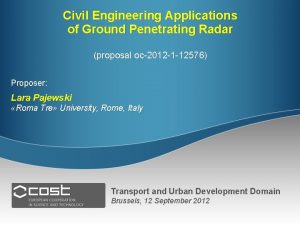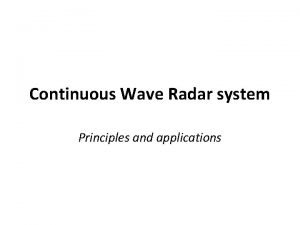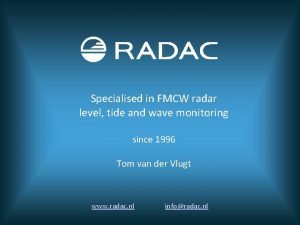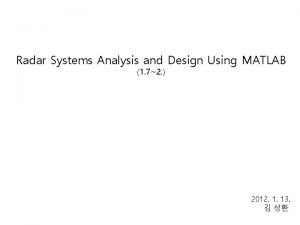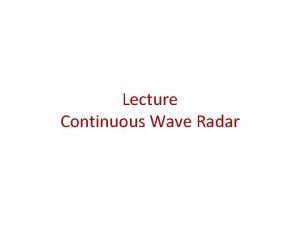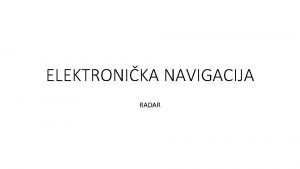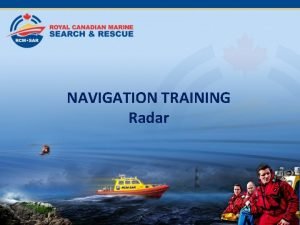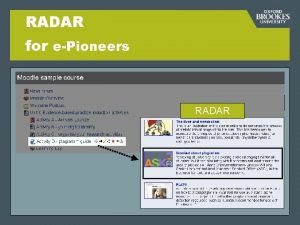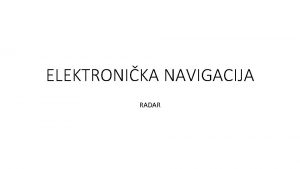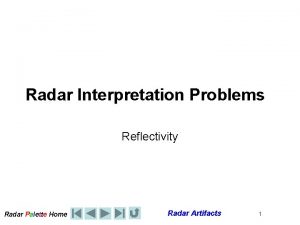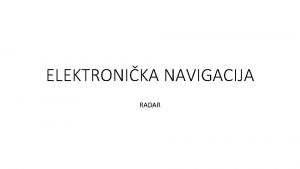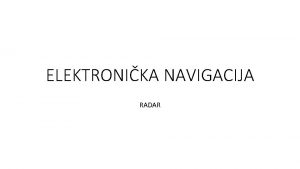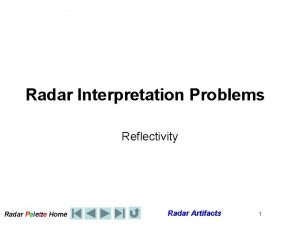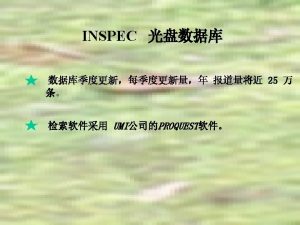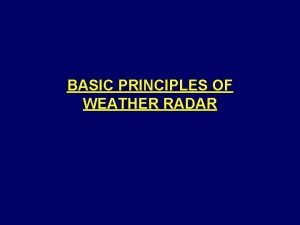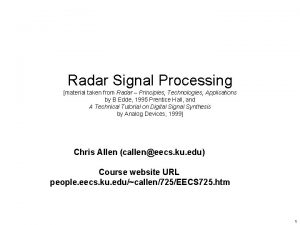Continuous Wave Radar system Principles and applications Continuous



![FM-CW radar theory [4] • The modulation parameters are frequency deviation, f, and modulation FM-CW radar theory [4] • The modulation parameters are frequency deviation, f, and modulation](https://slidetodoc.com/presentation_image/cd233ceb84c9819dabf5f5ac02e58921/image-4.jpg)
![FM-CW radar theory [4] FM-CW radar theory [4]](https://slidetodoc.com/presentation_image/cd233ceb84c9819dabf5f5ac02e58921/image-5.jpg)
![FM-CW radar theory [4] • closing target FM-CW radar theory [4] • closing target](https://slidetodoc.com/presentation_image/cd233ceb84c9819dabf5f5ac02e58921/image-6.jpg)
![FM-CW radar theory [4] • Given an FM-CW radar with triangular frequency modulation of FM-CW radar theory [4] • Given an FM-CW radar with triangular frequency modulation of](https://slidetodoc.com/presentation_image/cd233ceb84c9819dabf5f5ac02e58921/image-7.jpg)
![FM-CW radar theory [4] • Recall that the range resolution of a radar is FM-CW radar theory [4] • Recall that the range resolution of a radar is](https://slidetodoc.com/presentation_image/cd233ceb84c9819dabf5f5ac02e58921/image-8.jpg)
![FM-CW radar architecture [4] FM-CW radar architecture [4]](https://slidetodoc.com/presentation_image/cd233ceb84c9819dabf5f5ac02e58921/image-9.jpg)
![CW Radar applications [1] • Radar altimeter • Terrain-following radar • CW illumination CW Radar applications [1] • Radar altimeter • Terrain-following radar • CW illumination](https://slidetodoc.com/presentation_image/cd233ceb84c9819dabf5f5ac02e58921/image-10.jpg)

![Terrain-following radar [1] Terrain-following radar [1]](https://slidetodoc.com/presentation_image/cd233ceb84c9819dabf5f5ac02e58921/image-12.jpg)
![CW illumination [1] • Used in conjunction with semiactive missiles. The aircraft radar “illuminates” CW illumination [1] • Used in conjunction with semiactive missiles. The aircraft radar “illuminates”](https://slidetodoc.com/presentation_image/cd233ceb84c9819dabf5f5ac02e58921/image-13.jpg)




- Slides: 17

Continuous Wave Radar system Principles and applications

Continuous Wave Radar • Employs continual RADAR transmission • Separate transmit and receive antennas • Relies on the “DOPPLER SHIFT”

FM-CW radar • An unmodulated CW radar is incapable of detecting range, as there is no reference point in the transmitted or returned signal for measuring elapsed time. • By frequency modulating the CW signal, differences between the transmitted and received frequencies can be used to estimate range. – The further the target, the larger the frequency difference.
![FMCW radar theory 4 The modulation parameters are frequency deviation f and modulation FM-CW radar theory [4] • The modulation parameters are frequency deviation, f, and modulation](https://slidetodoc.com/presentation_image/cd233ceb84c9819dabf5f5ac02e58921/image-4.jpg)
FM-CW radar theory [4] • The modulation parameters are frequency deviation, f, and modulation period, Tm.
![FMCW radar theory 4 FM-CW radar theory [4]](https://slidetodoc.com/presentation_image/cd233ceb84c9819dabf5f5ac02e58921/image-5.jpg)
FM-CW radar theory [4]
![FMCW radar theory 4 closing target FM-CW radar theory [4] • closing target](https://slidetodoc.com/presentation_image/cd233ceb84c9819dabf5f5ac02e58921/image-6.jpg)
FM-CW radar theory [4] • closing target
![FMCW radar theory 4 Given an FMCW radar with triangular frequency modulation of FM-CW radar theory [4] • Given an FM-CW radar with triangular frequency modulation of](https://slidetodoc.com/presentation_image/cd233ceb84c9819dabf5f5ac02e58921/image-7.jpg)
FM-CW radar theory [4] • Given an FM-CW radar with triangular frequency modulation of fm and frequency deviation f, the range of a stationary target can be derived as follows: fb = tr dft/dt, where the round-trip transit time, tr = 2 R/c, and the changing transmit frequency, dft/dt = 4 fm f. Therefore fb =(8 Rfm f/c), or R = cfb/(8 fm f)
![FMCW radar theory 4 Recall that the range resolution of a radar is FM-CW radar theory [4] • Recall that the range resolution of a radar is](https://slidetodoc.com/presentation_image/cd233ceb84c9819dabf5f5ac02e58921/image-8.jpg)
FM-CW radar theory [4] • Recall that the range resolution of a radar is a measure of its ability to distinguish closely spaced targets. The range resolution of a FM-CW radar is a function of its modulating bandwidth, and is c/(4 f). • The range ambiguity is the range beyond which the radar yields ambiguous range results. The range ambiguity of a FM-CW radar is a function of its modulating frequency, and is c. Tm. – This is usually well beyond the signal range.
![FMCW radar architecture 4 FM-CW radar architecture [4]](https://slidetodoc.com/presentation_image/cd233ceb84c9819dabf5f5ac02e58921/image-9.jpg)
FM-CW radar architecture [4]
![CW Radar applications 1 Radar altimeter Terrainfollowing radar CW illumination CW Radar applications [1] • Radar altimeter • Terrain-following radar • CW illumination](https://slidetodoc.com/presentation_image/cd233ceb84c9819dabf5f5ac02e58921/image-10.jpg)
CW Radar applications [1] • Radar altimeter • Terrain-following radar • CW illumination

Radar altimeter • Triangular FM-CW radar is commonly used in aircraft to determine the instantaneous altitude above the terrain it is flying.
![Terrainfollowing radar 1 Terrain-following radar [1]](https://slidetodoc.com/presentation_image/cd233ceb84c9819dabf5f5ac02e58921/image-12.jpg)
Terrain-following radar [1]
![CW illumination 1 Used in conjunction with semiactive missiles The aircraft radar illuminates CW illumination [1] • Used in conjunction with semiactive missiles. The aircraft radar “illuminates”](https://slidetodoc.com/presentation_image/cd233ceb84c9819dabf5f5ac02e58921/image-13.jpg)
CW illumination [1] • Used in conjunction with semiactive missiles. The aircraft radar “illuminates” the target, while the missile uses the received return signal to track the target. • What are the advantages and disadvantages?

Pulse Vs. Continuous Wave radar • • Pulse Echo Single Antenna Gives Range, usually Alt. as well Susceptible To Jamming Physical Range Determined By PW and PRF. • • • Continuous Wave Requires 2 Antennae Range or Alt. Info High SNR More Difficult to Jam But Easily Deceived Amp can be tuned to look for expected frequencies

exercise • Recalling the radar range equation, why is it possible for a CW radar to achieve much greater ranges than a pulsed radar? • Can you think of an application in sports where a simple Doppler radar may be employed?

Doppler calculation • • Just after take-off you realize that you are following a military CC-138 (Twin Otter) in a Cessna 152. Your air speed is 190 km/hour. You estimate that the Twin Otter is at an approximate 15 angle above you. You have a “home-made” 10. 6 GHz Doppler radar installed on the Cessna oriented straight ahead. a. If the beat frequency on your Doppler radar is 1517 Hz, what is speed of the Twin Otter? b. What range resolution can you get with this crude radar?

Radar altimeter calculation • An aircraft is equipped with an FM-CW radar altimeter with a modulation frequency of 1. 0 k. Hz and a frequency deviation of 0. 60 MHz. a. Compute the beat frequency as a function of range. b. If the system has a measured beat frequency of 60 k. Hz, what is the aircraft altitude? c. What is the range resolution of the altimeter? d. What frequency variation in MHz is required to give a range resolution of 10 m?
 Limitations of mti radar
Limitations of mti radar Mti versus pulse doppler radar
Mti versus pulse doppler radar Civil engineering applications of ground penetrating radar
Civil engineering applications of ground penetrating radar Application of cw radar
Application of cw radar Radar
Radar Difference between full wave and half wave rectifier
Difference between full wave and half wave rectifier Example of longitudinal wave
Example of longitudinal wave Full-wave rectification
Full-wave rectification Earthquake p wave and swave travel time
Earthquake p wave and swave travel time Mechanical and electromagnetic waves
Mechanical and electromagnetic waves Similarities of mechanical and electromagnetic waves
Similarities of mechanical and electromagnetic waves Velocity frequency wavelength triangle
Velocity frequency wavelength triangle Radar systems analysis and design using matlab
Radar systems analysis and design using matlab Light is an electromagnetic wave true or false
Light is an electromagnetic wave true or false Carbon dioxide temperature
Carbon dioxide temperature Full wave rectifier vs half wave rectifier
Full wave rectifier vs half wave rectifier Rectified sine wave fourier series
Rectified sine wave fourier series Nature of sound wave
Nature of sound wave


